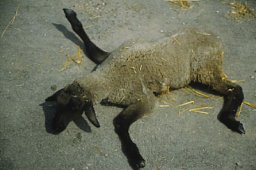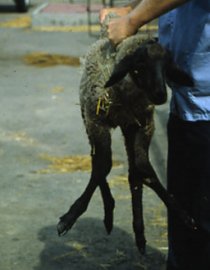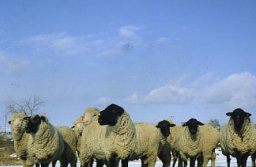Spider Lamb Syndrome
Introduction
Spider lamb syndrome or hereditary chondrodysplasia is a condition found primarily in blackface sheep, most commonly Suffolk (75%) and Hampshire (25%). The first reported occurrence of a "spider lamb" (a phrase picked up from Southern Minnesota sheep ranchers) was in 1980. Within the next five years there was a dramatic increase in the incidence of spider lambs. Lambs may be born without any detectable abnormalities, but by four to six weeks of age deformities of the legs and spine can be noted. Due to these deformities, these lambs have difficulty nursing and seldom survive.
Clinical Signs

At birth, although obvious deformities cannot be detected, an experienced producer may be able to distinguish these lambs by their increased limb length to body ratio, long neck length and Roman-shaped nose.
As these lambs grow angular limb deformities (medial deviation of the carpus), degenerative changes in the joints, arthrogryposis (legs are fixed in flexure) develops within the first month of life. Typically these signs are seen in the front limbs but 59% of affected lambs will have deformities of the hind legs as well. Spinal curvature (scoliosis or kyphosis), facial deformities and muscle atrophy may also become more pronounced. North Dakota State University Diagnostic Laboratory reported that other malformations, such as deviated nasal septum, interventricular septal defects, and hydrocephalus were detected during necropsies.
Prevention

Because this is a genetic condition, it is very difficult to eliminate from one's flock. Lambs that are born homozygous for Spider Lamb Syndrome typically do not survive to breeding age, unless bottle-fed. Even if these lambs survive to breeding age, they should not be used for breeding since their progeny have at least a 50% probability of being born as carriers for the gene. Ewes that are carriers (heterozygous) for Spider Syndrome are difficult to detect and for most practical situations, the only test of determining if a ewe is a carrier for the gene is from breeding that ewe and obtaining spider lambs from that ewe.
Recently, scientist from Utah State University have developed a DNA test to determine if sheep can be identified as "carriers" for the spider lamb syndrome. Presently, Genetech (Ft. Collins, CO; $18.00 per sample and with over 50 samples they charge $17.00 per sample, 2/00) and Livestock Molecular Research and Development (Monticello, IL) are biotechnology companies that can test a blood or semen sample from ewes for the presence of the gene for Spider Lamb Syndrome.
Unfortunately it is extremely difficult to eliminate all carriers from a flock and once eradication of all carriers has been established, the herdsperson must be extremely careful not to introduce a ram or ewe that is a carrier for the defective gene.

Reference
Cockett, N.E., T.L. Shay, J.E. Beever, D. Nielsen, J. Albretsen, M. Georges, K. Peterson, A. Stephens, W. Vernon, O. Timofeevskaia, S. South, J. Mork, A. Maciulis, T.D. Bunch. Localization of the locus causing Spider Lamb Syndrome to the distal end of ovine Chromosome 6. Mamm Genome, Vol 10 (1), 35-8, 1999.
Linklater, K.A., M.C. Smith. Color Atlas of Diseases and Disorders of the Sheep and Goat. Wolfe Publishing. 1993.
Rook, J.S., A.L. Trapp, J. Krehbiel, B. Yamini, M. Benson. Diagnosis of hereditary chondrodysplasia (spider lamb syndrome) in sheep. JAVMA, Vol 193 (6), 713-8, 1988.
Vanek, J.A., A.D. Alstad, I.E. Berg, A.R. Misek, B.L. Moore, W. Limesand. Spider syndrome in lambs: A clinical and postmortem analysis. Vet Med, Vol 81 (1), 663-8, 1986.
Prepared by Cleon V. Kimberling and Terri Taraska
Optimal Livestock Services, LLC
970-231-2477
Copyright © 2016 CleonsCorner.com All Rights Reserved
